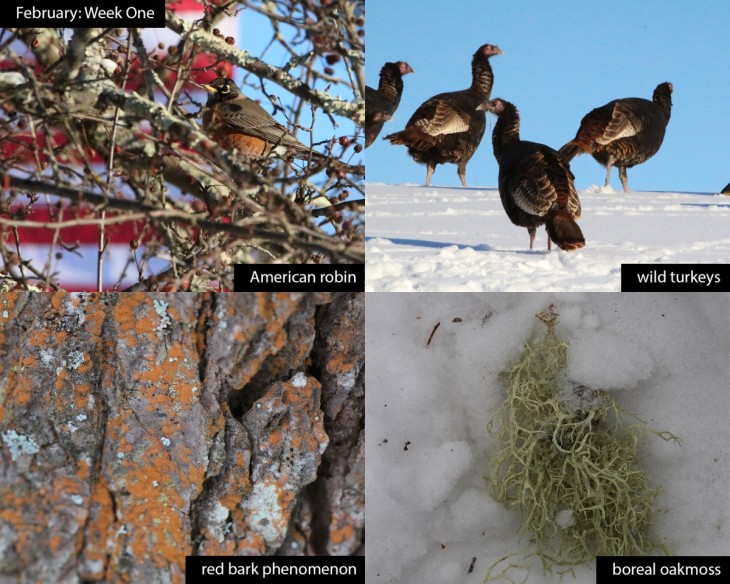This week in the woods, we observed a large flock of American robins feeding in a crabapple tree – and perhaps getting drunk. Because sugars in fruit can ferment over the course of the year, robins and other frugivorous birds such as starlings and waxwings can become intoxicated from their winter diets. This can lead to collisions with obstacles, failure to avoid predators, or even death by alcohol poisoning. As recently as the 1990s, seeing this partial migrant in northern New England at this time of year would have warranted surprise, but it now has a year-round presence.
Another American icon, the wild turkey has both distinguished progeny and distinguished forebears: the much heavier domestic turkey was, of course, bred from wild turkeys, and genomic research shows that the wild turkey is genetically closer to its dinosaur ancestors than any other bird. In the twentieth century, the turkey almost went the way of the dinosaur, at least in the eastern states, due to overhunting and habitat loss. Reintroduction between the 1960s and 1980s led to a strong recovery, with populations increased and stabilized in all of the lower 48 states. Turkeys forage and roost in single-sex flocks during the winter, separating into adult males (toms), young males (jakes), and females (hens) of all ages. With so much of turkeys’ plant diet found on the ground, snow cover can significantly affect their survival rates. When acorns, beechnuts, forbs, grasses, and other vegetative edibles are covered or iced over, fertile fern fronds sticking above the snow and scattered agricultural grains can prove essential for sustenance.
Red bark phenomenon (RBP) is a crusty or filmy condition caused by green algae containing orange-red pigments and affecting numerous tree species. Only detected in New England within the past 20 years, it has so far shown no known threats to tree or forest health. The Connecticut Agricultural Experiment Station notes that trends linked to climate change may have contributed to the increased prevalence of RBP across the region.
Boreal oakmoss is a lichen, not a moss, and lives on numerous trees other than oaks – and may even prefer conifers. The common, shrubby (or “fruticose”) lichen often grows on the very ends of branches, a situation conducive both to dispersing its soredia (the clusters of algal cells wrapped in fungal filaments used for asexual vegetative reproduction) and to specimens like this one breaking off and falling to the forest floor. It’s best to avoid handling boreal oakmoss, as the usnic acid it contains can irritate the skin.
What have you noticed in the woods this week? Submit a recent photo for possible inclusion in our monthly online Reader Photo Gallery.


